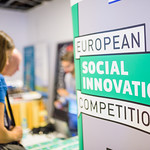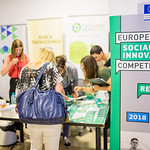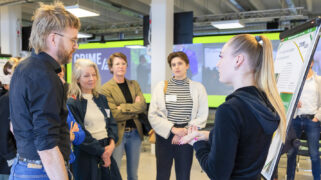How to make social innovation successful in Europe: learnings from a three-day pressure cooker
During the social innovation academy in Cluj-Napoca five building blocks surfaced that are crucial for successful social innovation in Europe.
- Betrokken KL'ers
- Tessa de Geus
- Stéphanie van der Raad
- Nora van der Linden

Deelnemers van de European Social Innovation Competition Academy tijdens een pitchworkshop.
Maker: Vlad Cupşa
DownloadFrom 16 to 18 July the social innovation academy of the European Social Innovation Competition took place in Cluj-Napoca. Thirty semi-finalists++Thirty semi-finalistsRead more about the ideas of our semi-finalists here. were invited to collectively learn, reflect and think ahead of how they can best implement their ideas to provide opportunity for youth++This year’s themeThis year, the theme of the competition is ‘RE:THINK Local’ – calling Europeans to submit their ideas for providing opportunity for youth by using local resources and qualities.. In this pressure cooker setting, five building blocks surfaced that are crucial to make social innovation successful in Europe.
The setting for the academy was Romania’s second city: Cluj-Napoca. As one of Europe’s poorest countries, Romania is facing high emigration rates among its young population, particularly in rural areas. Young people move to European countries such as Italy, Spain, Germany and the UK in large numbers, or choose to live in cities such as Bucharest. Cluj also makes for a popular destination among young Romanians. CAs one of Europe’s poorest countries, Romania is facing high emigration rates among its young population.luj is well-known for its flourishing IT-sector++Flourishing IT-sectorRead more about how the IT-sector drives the development of Cluj-Napoca in this article. , as well as lively scene of youth initiatives++Youth initiativesFor instance successful intiatives like the young rural cooperatives programme run by Civitas, a former semi-finalist of the 2014 edition of the competition., resulting in its nomination as the European Youth Capital in 2015.
For organising the social innovation academy we tapped into the knowledge and skills of many local organisations, ranging from Ashoka Romania, Pro Vobis, Spherik Accelerator to Cluj Cultural Centre. The three-day programme included workshops, showcases of local social innovation and interactive discussions with peers and experts. Five insights clearly surfaced during the academy; read about them below.
1. Social innovation as a European movement
On the first day the academy explored the value of social innovation as a pan-European movement. Discussing statements including “Social innovation can’t work unless it’s locally embedded”, “In my country young people have equal opportunity” and “It requires particular knowledge and skills to work with youth”, the participants learned about the conditions for social innovation in other European countries and started to reflect on how their innovation might work in a different context, and how they embed their project locally.
It became clear that social innovators among each other have great potential to increase their impact when learning about how their insights apply to other European contexts. Not only does this generate recognition of the importance of social innovation in European countries, but it also sparks new ideas and collaborations for social good. This could already be seen among semi-finalists who started exploring possible combinations of their ideas and ways to export their ideas across bordersSocial innovators among each other have great potential to increase their impact when learning about how their insights apply to other European contexts..
2. Good intentions ≠ good outcomes
Another building block concerns an existential topic for social innovation:++Forget about impact, let’s be honest about systems changeWe recently published a critical article about the value of measuring impact, you can read it here. systemic impact. Good intentions do not equal good outcomes. Even when outcomes may appear effective at the surface by providing effective products or services, the social innovation might still not be reaching its full potential. This full potential refers to transformative impact – impact to change systems, and create better outcomes for people sustainably on a large scale. This means started out with a thorough problem analysis, to make sure your are not merely addressing symptoms of a problem, but rather target underlying causes and mindsets. Ashoka Romania hosted a workshop on systemic change and reporting on social impact in order for the semi-finalists to reflect on this systemic impact strategy.
By discussing questions such as ‘How do you know that you are achieving positive social change?’ and ‘How do you demonstrate this social impact?’, they guided semi-finalists from formulating a vision for the future to analysing the resources, relations, roles, rules and results of the current system they are acting in, and linking this with their concrete activities. The next step is to report about this impact through the openly available Social Reporting Standard as developed by Ashoka, to get people on board to your mission.
3. Invest to test
Penny Evans and Carolyn Hassan from the Knowle West Media Centre demonstrated that social innovation and solving problems can be fun as well as particularly effective when using the steps of The Bristol Approach++The Bristol ApproachVisit their website to learn about The Bristol Approach. . This approach consists of six phases: identification, framing, design, deployment, orchestration and outcome. Key takeaways for the semi-finalists included the need to organise events to introduce their idea to the public and celebrate what has already been achieved, as well as inviting stakeholders to the table to learn about their perspectives and co-design possible solutions. Throughout their workshop, Penny and Carolyn emphasised that social innovation starts with (framing) the problem: “YouYou must always ask yourself the question: have I truely identified the problem? must always ask yourself the question: have I truely identified the problem?”++Out toolkitMore information on how to take this important first step? Read the first chapter of our toolkit.
According to Carmen Ciobanu from Civitas, who hosted a workshop about user-centred design, involving stakeholders and end users carefully is especially important when testing your solution for a social issue. Observing the effects of your solution in the real world and to quickly adapt your concept accordingly also means to take into account ethical considerations – an unsuccessful product can have serious negative consequences on people’s’ lives. In other words: invest to test.
4. Choose a business model that empowers your idea
Mircea Vadan from Spherik Accelerator explained how a clear business model helps you to map out your initiative, understand the need among your target group, your value proposition, as well as your sources of revenue, key activities, and essential partners. Here you learn how to use the business model canvas. It’s important to find a business model that empowers your idea: as an example he mentioned Xerox, who only started to become successful after they switched from selling to leasing their printers.
The same goes for finding the right partners and creating a meaningful community around your social initiative, according to Stefan Teisanu who gave a workshop on community building. In order to identify key players and stakeholders worth approaching++Strategic partnerschipsRead more about strategic partnerships and how to use The Partnership Canvas in this article.
, you have to identify how important the stakeholder is for your project and in what way each stakeholder might be interested in your idea. For instance, does the stakeholder want to make profit or gain resources through your initiative? Or is the stakeholder looking for positive publicity through being involved in your initiative?
In his workshop on forging partnerships, Ciprian Stanescu from Ashoka Romania emphasised the importance of exploring all the different ways in which a partner can help you and the various things you could offer in return. Look at a partnership in a more creative way than just getting a sponsorship or moneyExplore all the different ways in which at a partnership can help and look at a partnerschip in a more creative way than just getting a sponsorship or money.. For example, partners are often interested in opportunities for their staff to get involved in social initiatives as a way of improving their job satisfaction, such experience you can offer through your social initiative.
5. Never underestimate the power of a strong narrative
Many innovations in the competition are place-based – scaling up in the classical sense might not be suitable for all projects. Therefore, a strong convincing narrative is arguably even more important than for regular businesses, seeing as the transformative power of social innovation lies in affecting change among other actors in the system initiatives operate in.
The final day of the academy focussed on crafting a narrative to spread your idea and interest potential partners or funders. Pitch trainer Matt Boardman came in from Madrid to prepare the semi-finalists for their pitch in front of the judging panel++Judging panelWe have an impressive judging panel with experienced social innovation professionals. , but he was sure to note that most pitching doesn’t happen on a stage: everytime you tell someone about your idea you want them to become a fan, and you need a convincing pitch for that.
By analysing the plot lines of the semi-finalists’ favorite movies (ranging from Titanic to Forrest Gump) Matt demonstrated that in order to get your message across you need to work on the right dynamic: balancing out pathos (emotional appeal), ethos (showing your credibility and experience) and logos (facts and testimonial backing of your argument).
FEverytime you tell someone about your idea you want them to become a fan.ollowing the academy, semi-finalists will submit a detailed plan of how plan to affect change by the end of August. Based on these plans, our judging panel selects ten finalists and three winners, who will each be awarded a € 50,000 prize at the awards ceremony in Brussels in November 2018.
Follow the latest updates and competition news on Twitter by following @EUSocialInnov and #diogochallenge and check out the pictures of the event below.












